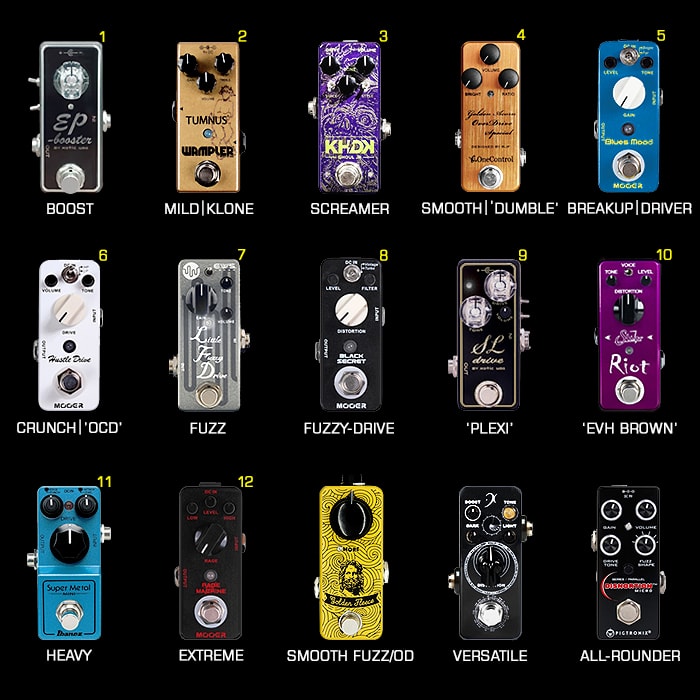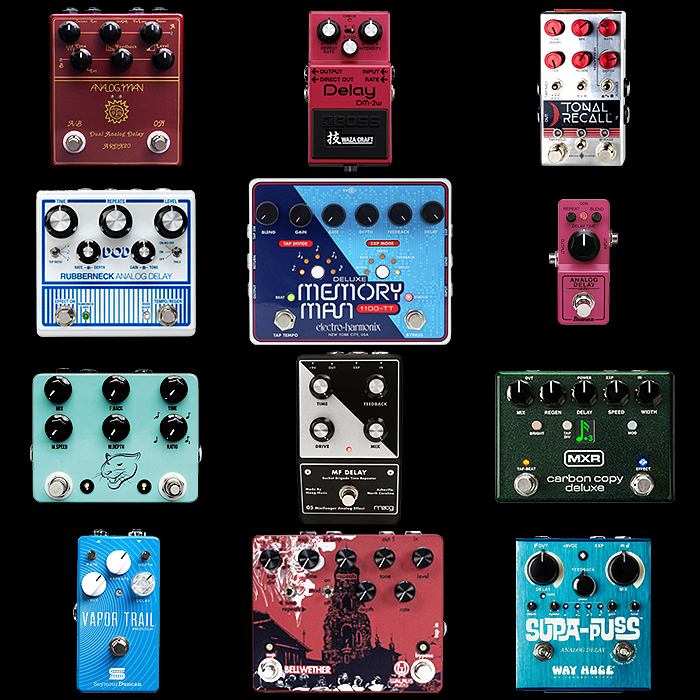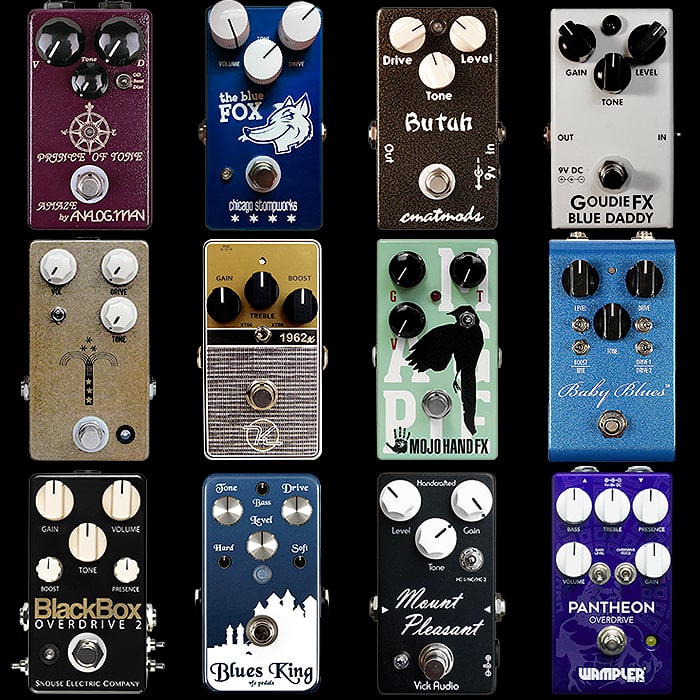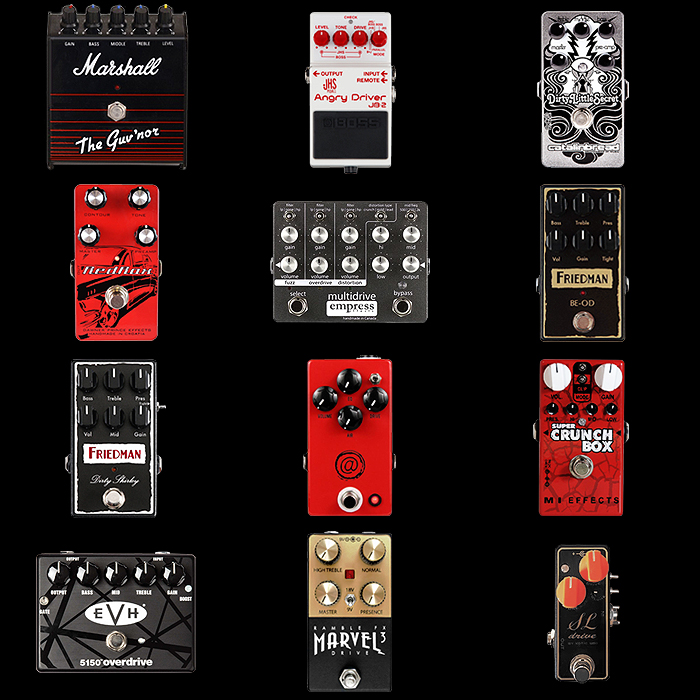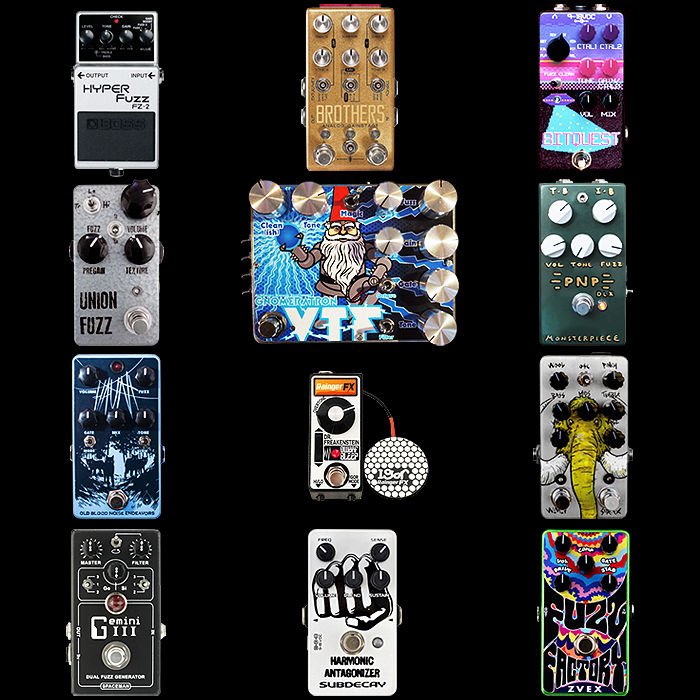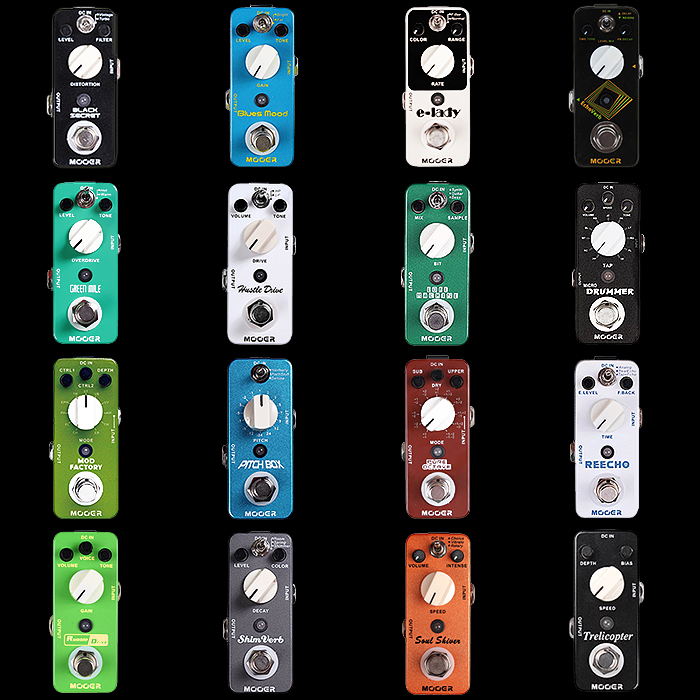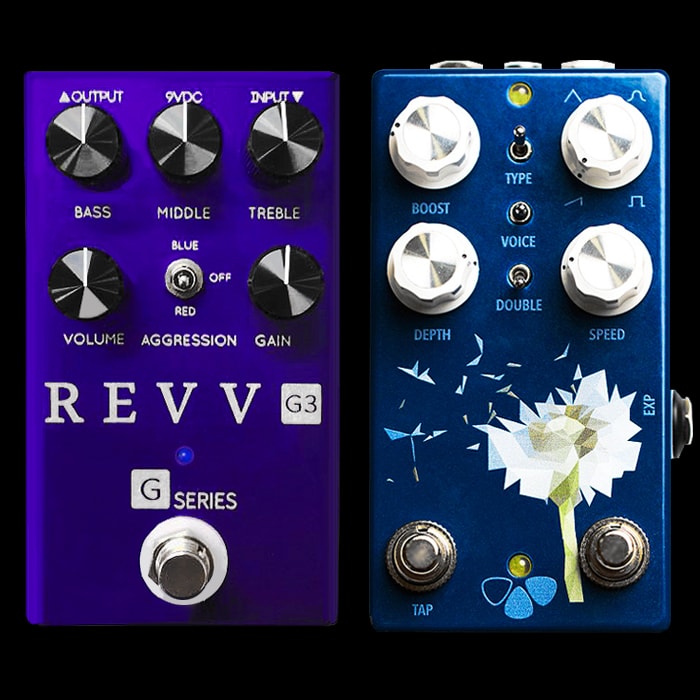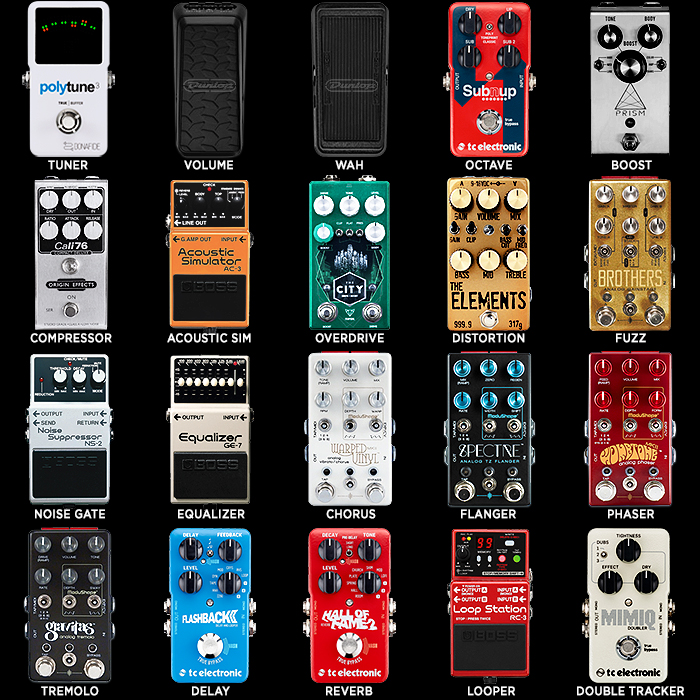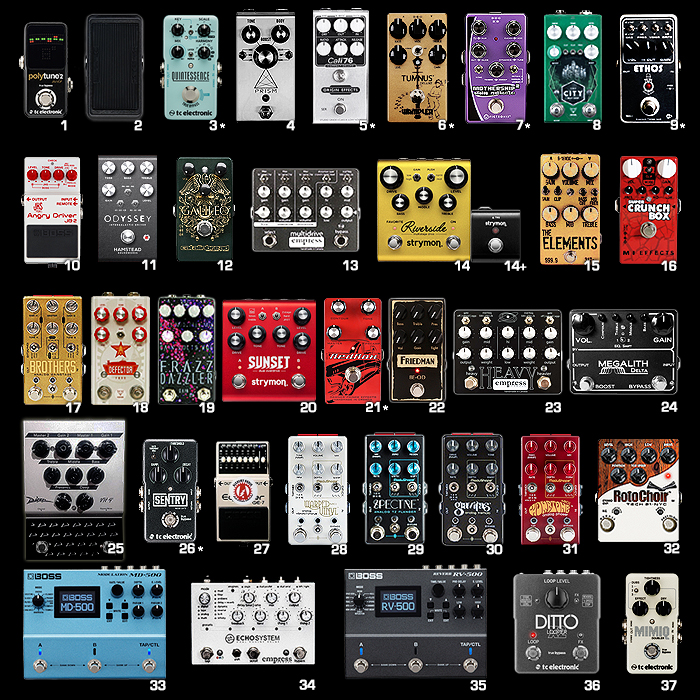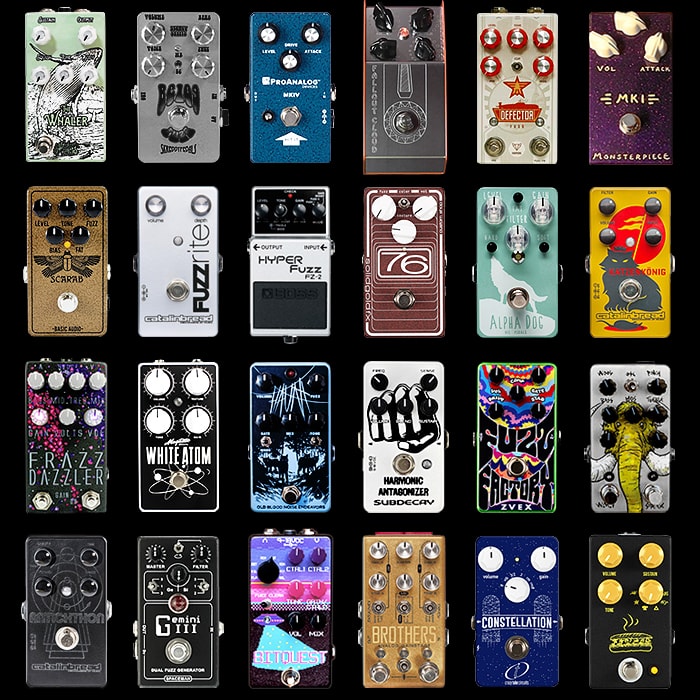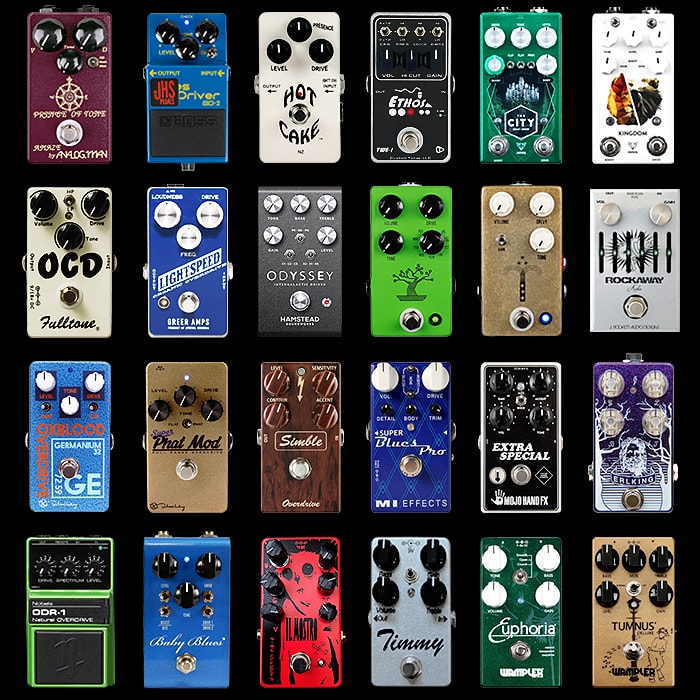35 of the Best Boss Compact Guitar Pedals - 2018 Update

So last year was the 40th anniversary of the Boss Compact Pedal (1977 - 2017) and I did a feature to commemorate that notable milestone. On that occasion I picked out 20 of my favourite Boss Compacts - past and present.
In the intervening time I’ve got more and more into Boss pedals - particularly modified versions, and have decided to extend the list to cover the additional pedals I am interested in. There is still a part of me that prefers the MXR-style enclosure, especially the twin footswitch variety.
Modern compact pedals increasingly have dual footswitches which have so far not materialised on Boss. I’m sure there is a way to split the hinge-plate to make this possible, but I’m not sure this will ever happen. Despite that limitation, Boss is still creating highly feature-rich and smart pedals, even though some of its pedals are now lagging significantly behind what this industry is capable of.
Lots of players overlook Boss because it is considered somewhat old-fashioned and slow moving, but you can see how it has completely taken over the world of amps of late, and their does seem to be a revival of sorts for its pedals - many of which still sound and work exceptionally. Boss still has that bullet-proof build quality that few can revival - most Boss pedals are for life, regardless of the kind of punishment they endure.
There are still several categories where Boss has very significant penetrations, and ironically it overlaps with its young pretender TC Electronic for both Loopers and Tuners - between them they sort of have most of the market for those types. Boss still makes some of the best-sounding Chorus pedals of all-time, and I still dearly love the Blues-Driver in all its guises. There are lots of discontinued pedals which are in high demand - like the ’63 Fender Spring Reverb, and Dimension C Chorus, and Swedish Death Metal would be nowhere without the HM-2 Heavy Metal pedal.
I feel pretty much all of the above are classics in their own way, and all are worthy of investment. Of course there is much ado about acquiring original Japanese-made versions which typically have better quality component parts. But I increasingly look towards the modded-route - where modders upgrade the lesser quality parts and add additional voicings as well as ’taming’ some of the fizzier elements.
Most professional players still use a slew of Boss pedals -so its credentials are never in doubt really - these pedals are always reliable, and in sufficient distribution to quickly replace if anything goes wrong. I’ve never had a single issue with any of my Boss pedals - even those which are 20 , 30 or more years old. Not every Boss is a classic, and several need to be tweaked around with to get right, but few companies are as consistently reliable as these.
Several of the more in-demand older pedals are on sale on Reverb.com and eBay for £300-£400 and frankly they are rarely worth that premium, particularly considering the overall condition most of them are in. What I try to do is find examples in as pristine condition as possible, and frankly for something that old, you’re unlikely to find much above ’Very Good’ - in fact most are simply ’Fair’ condition, and don’t justify near-mint prices. The sweetspot for me is around £200-£250 - but you need to do your own due diligence, and can’t in the slightest rely on the quality grading the seller has given - also be prepared to haggle - you can make an offer on Reverb after all.
When I did my original Boss Compacts piece, I was always sort of unhappy with the order - I think I’ve got that much better this time around - mostly in alphabetical order by pedal name vs code designation, and with pedals grouped within family categories. Note that pedals marked with green ticks are already in the collection, while the orange arrows indicate targets for acquisition. Pedals have year of introduction to their right, ’M’ indicates modified version, and ’x’ indicates it is now discontinued.
'63 Fender Reverb FRV-1 (2009 - 2016) - c£200 for pristine on Reverb.com (£115 when new)
This pedal appeared in my piece on Spring Reverb pedals, the FRV-1 has found favour with a lot of 60's surf-rock enthusiasts (in fact appears on several pro-boards), and is most definitely one of the main ones for consideration within that category - if you are looking for that vintage Fender amp spring-tank reverb sound - then this gets you very very close. These are now wholly inflated on Reverb.com - and you're probably best of letting the storm quiet down a touch. Pedals always shoot up in value after cancellation, and then creep down slightly before spiking every now - so getting one at a reasonable price is all about timing and luck, they are recent pedals though, so pedal condition should not be a major factor her - just getting one at a justifiable price.
Acoustic Simulator AC-3 (since 2006) - £105
Boss pretty much owns this category - it's the only one providing a compact size Acoustic Simulator, in fact few pedal-makers provide an alternative to this. There is the diminutive Mooer Acoustikar clone, and then a couple of lower-cost Chinese clones, but really not much else. Many of the purists frown at this effect, but it works well enough if you want to stick with just one guitar and get some acoustic-style tones during your live set. I've long considered getting one of these, and there really isn't much competition to this one at all.
Angry Driver JB-2 (since 2017) (Blues Driver BD-2w) - £179
Of all the recent Boss Compact Pedal releases, this one had me the most excited. For a long time my preferred 'Blues Driver' was actually a mini Mooer Blues Mood - which is a clone of the Keeley Phat Blues Driver Mod. The Angry Driver is hugely versatile - giving you both the Boss Blues Drive circuit as well as the JHS JCM800-style Angry Charlie circuit - you can mix those two up in series and parallel with dual sets of tone controls - set out in dual-concentric fashion. For a very long time the Blues Mood was my favourite Blues Driver, while currently I alternate between this Angry Driver and the Keeley Freak Fuzz modded Blues Driver - which contains both Phat and Freak mods for extended tone-sculpting ability. The 'Blues Driver' type is probably my favourite Boss family - which is why I essentially include 3 varieties in this listing.
Blues Driver BD-2 (since 1995) Keeley Freak Fuzz Mod - c£160 (Reverb.com)
I kind of lucked out on Reverb.com when I came across this pedal in pretty decent condition and for a pretty reasonable price of £160 including delivery. And while there are more 'Phat Mod' versions out there, the 'Freak Fuzz' version which includes both Phat and Freak mods - and has those very evident dual additional transistors on the surface of the pedal - is pretty much rare as hens teeth. I cannot find any videos in the wild that feature this version, but there are plenty which cover the Phat Mod - as is indeed covered above. Generally the overall tonal profile of the stock pedal is improved by using better quality components and taming some of the top-end fizz, while boosting lower frequencies. You end up with a much creamier overdrive / distortion and quite a distinct voicing from either the stock Boss Blues Driver or the Waza Craft Version. I'm very happy I got mine, and it is currently on the board in place of the Angry Driver, but I do swap them around fairly regularly. The above demo video pretty aptly demonstrates some of the finer qualities of the Phat Mod.
Blues Driver BD-2w Waza Craft (since 2014) - £121
Boss sells two versions of the Blues Driver - the original stock version, as well as the more dynamic and refined Waza Craft version featuring better quality internal components and a Standard / Custom voicing switch. On first impressions there does not sound to be too much difference between these, but the Waza Craft has a touch more articulation and generally a slightly smoother and more refined output - particularly in the 'Custom' mode. Some may find the differences almost indistinguishable - but they are clearer at loud volumes and higher levels of saturation. Both are excellent pedals, and the original is fine if you like the slightly rawer side of the Blues Drive and don't wish to pay a £50 premium for Waza (£73 vs £121). If I did not have the Keeley-modded Freak Fuzz version, I would probably go for the Waza Craft, but many will prefer the original. The Freak Fuzz gives me a better, richer core tone, with two very usable voicing additions via the Mod switches - so if you can find one, that would be my recommendation.
Chorus CE-2w Waza Craft (Since 2016) - £169
Boss ruled the 80's with its chorus pedals, this recreation of the original compact Chorus Ensemble - now in Waza form with the added benefit of spacey Stereo output. I am slightly less interested in this than I should be since the new Boss MD-500 Modulation workstation does such a wonderful job with Choruses. It was an area of my Strymon Mobius that I did not use particularly much, but the Boss and Roland Choruses have always been stellar - and sound amazing on the larger MD-500 pedal. If I did not have the MD-500 I would definitely acquire one of the Boss Choruses - either this one or the CH-1 Super Chorus - which is slightly thicker than CE-5 Chorus Ensemble - while the latter has more tonal control.
Chromatic Tuner TU-3 (Since 2010) - £59
The Boss Tuner has been in its current format since 2010 and still finds favour on a very significant number of pro pedalboards. Last year also saw a release of an all-black Waza version of this (TU-3w) which I mark down a smidge for its slight drop in clarity and legibility - at least to my eyes. The TU-3 is a clear and accurate tuner, personally I prefer the TCE PolyTune Mini which is smaller and can give you a reading on all 6 strings simultaneously. The TU-3 is likely more accurate though - and is also available in a shorter sort of screen-only version - the TU-3S.
Compressor CP-1X (Since 2016) - £121
When I was in the midst of constructing the core of my pedal-chain last year, this was for a while the front-runner for Compressor, yet its delayed release / lack of initial availability forced me to look elsewhere, first to the Mini Xotic SP Compressor, and then latterly to my now current Wampler Mini Ego. I find I prefer the mini pedal-size for this function, and there are lots of really decent Compressor pedals around now - including ones from Keeley and Origin Effects, which the professionals largely seem to prefer. The CP-1X is no doubt still in the running, but just missed out on a mention in my 9 Best Compressor Pedals article. In fact, based on my experience of the Origin Effects RevivalDrive, I've kind of decided I'm going to switch up to the Cali76 Compact Deluxe Compressor - with its 6 contol dials. I put that ahead of the Wampler Ego, Bondi Effects 2026, Greer Amps Lamplighter and Keeley Compressor Plus - which though are all excellent too - there is certainly no shortage of great compressors, which has meant this Boss one is somewhat overlooked - oh and the MXR Studio Compressor - as I said, not shortage of great ones - although there can be a significant difference in price.
Delay (Analog) DM-2w Waza Craft (since 2014) - £129
Boss re-launched modern updates of a number of its more celebrated vintage compact pedals, including the much loved DM-2 Analog Delay back in 2014. The Waza designation means it covers very high-spec Boss lab recreations where components are sourced as close to the originals (very high quality) as is achievable. This pedal also be featured in my piece on Analogue Delays. This is truly one of the great analogue delays, but I would probably prefer to go for the Ibanez Mini, which does exactly the same sort of thing in a much smaller enclosure. Sounds amazing though.
Digital Delay DD-7 (Since 2008) - £118
I was surprised to see that this pedal was quite so old. It's a really decent delay pedal for sure, particularly considering its size, yet just missed out on my Delay Workstation overview - where it was pipped by the new TC Electronic Flashback 2. Boss' larger DD-500 workstation was featured though and is one of the preferred selections. The recent firmware updates brought it more up to spec with the slightly more impressive MD-500 and RV-500. For the DD-7 though to have tap-tempo, subdivisions, modulation and 3 seconds of delay in this form factor and back in 2008 is pretty cool. It is fairly evident though that the TC Electronic Flashback has somewhat outpaced it more recently - perhaps the DD-8 is just around the corner. An important point here is that this pedal is fully stereo, and there are not many of those within the compact form factor - you kind of have this one, the DigiTech Obscura, and the aforementioned TC Electronic Flashback 2.
Dimension C DC-2 (1985 - 1989) - c£350 (Reverb.com)
This is one I've had my eyes on for a while - I actually overlooked its mention on the previous Boss Compact Feature. This is kind of a Chorus, but not really a Chorus - it works somewhat differently and just makes things sound bigger and wider - as intended in Stereo, and following on from the original Roland Dimension D rack-mounted device. Dimension C pedals in decent condition are fetching as much as £350 nowadays on Reverb.com, with lots of rather worn looking ones still at £270+. In fact something not unnoticed by TC Electronic who released their own 3rd Dimension clone of this last year - albeit in mono only! I'm sort of holding off on this one in the hope that Boss will see fit to reintroduce a Waza Craft version of this someday soon. £350 is quite a heavy outlay for this pedal vs TC's 3rd Dimension at £49 - however I feel TC is cheating somewhat in not delivering full stereo out - possibly they will do a more high-quality MASH-enhanced core range version of this in Stereo - we can only hope!
Distortion DS-1 (Black 40A Edition) JHS Synth Drive Mod (since 2017) - £155
In 2017 Boss released a specially packaged recreation of its 3 first compact pedals - the OD-1 OverDrive, PH-1 Phaser and SP-1 Spectrum Frequency Enhancer - to commemorate the 40th anniversary milestone - alas at an eye-watering £789. There are plenty of those still in stock, and now reduced to around £549 - but it's still a considerable outlay for essentially fairly basic pedals. I instead decided to get an Anniversary Black Edition of the DS-1 for a princely sum of £58. I later discovered that various pedal-makers had modded these, including Analog.Man and JHS. Neiter of those are available through UK suppliers - so my best friend was Reverb.com once more. JHS's Synth Drive Mod adds no less than 4 toggle voicing switches which take you through different gain stages, and into more synthy fuzz territory. This is a classic modded pedal and super versatile too - also much less expensive for commemorating Boss's 40th Compact Pedal Anniversary!
Distortion DS-1X (since 2014) - £117
First off, I'm not sure how valid the above comparison video between DS-1 and DS-1X really is as the method does not seem particularly scientific or based on total equivalency. In any case the DS-1X adds some digital processing on top of the core DS-1 circuit to get more playing dynamics out of the signal. Generally the DS-1X 'tames' the DS-1 while offering better overall frequency response. There are many that prefer the rawness of the DS-1 vs the slightly more compressed soundstage of the DS-1X. I actually like both, and consider them quite distinct pedals. When I first acquired the DS-1X I was a touch disappointed with it, as its dynamics are more in the mid-range frequencies, and does not have the modern heavy bass frequencies for instance - but once you know what you're dealing with you can get some really decent tones out of this. Do note that modern distortion pedals have far more oomph and gain than this - this one is more along earlier lower gain distortion vintage lines.
Mega Distortion MD-2 Alchemy Audio Mod (Since 2001) - £90 including delivery (Reverb.com)
When I bought the DS-1X above, this was in fact what I expected it to sound like! If you want more of that modern full-bore and harmonically rich distortion with plenty of oomph across the frequency range then this is your pedal. Many consider this Boss's best distortion pedal, and it's a surprise that more people haven't picked up on it! It's on my list to get - along with several others of course.
Dynamic Wah AW-3 (Since 2000) - £99
This pedal featured in my piece on Wah + Auto Wah pedals, and is a good option against the Maxon Auto Filter and Mad Professor Snow White Auto Wah. Depending on exactly what effect you are after, the Boss easily gives you the best bang for you buck. If you're just looking for a straight up Auto Wah you may prefer the AW-2 or other similar more-streamlined filter types.
Equalizer (Graphic ) GE-7 Alchemy Audio Mod (Since 1981) - £123 (Reverb.com)
Still the industry-standard pedalboard EQ, when I read up on the history I could not believe it goes all the way back to 1981 in this exact format. No doubt the internals have changed several times over that period, meaning I have both a recent original, as well as an Alchemy Modded version which switches out the key components with premium replacements for less unwanted noise and better tone. I've considered the Source Audio Programmable EQ and various parametric ones, but still think I like this one the best - it is clear, instant and consistent - it always works really well.
Flanger BF-2 Alchemy Audio Mod (1980-2001) - £105 (Reverb.com)
Andy Martin put me onto this - per the above video - just a great simple analogue Flanger with a great range of tones. Andy has a Japanese original in the above demo, I went for Johnny Balmer's Alchemy Audio modified version courtesy of Reverb.com - which swaps out internals with better quality components. I have 3 Flangers I now alternate on my board, with the Chase Bliss Spectre being the main one, and this one and the A/DA PBF as suitable swappable alternatives. You can't go wrong with one of these!
Hyper Fuzz FZ-2 (1993 - 1997) - c£200 (Reverb.com & Ebay)
I unfortunately overlooked this great Boss Fuzz pedal on all my previous sweeps for the original listing. Boss is rarely associated with Fuzz, but this is one sweet fuzz pedal and is many player's secret weapon - with 3 different voicings and separate Treble and Bass controls - overall based on the earlier Univox Super Fuzz and still rising in popularity. Second hand versions of these can be found on Reverb.com typically in excess of £200 which shows you just how much some people value these at. Possibly it's time Boss reissued this one too! I found mine on eBay actually - for a great price of £120 considering its excellent (well very good let's say) condition.
Fuzz FZ-3 (1997-1999) - c£100-120 (Reverb.com)
Even though the FZ-2 gets most of the love, you should not overlook this analogue silicon Fuzz Face sounding pedal. I'm not entirely clear on the insides, but I understand they are all analogue circuitry - whether OpAmp or transistors is not clear - but as per the above demo, the pedal has plenty of range. I got one in pretty decent condition off Reverb.com for £116. Depending on how battered you are willing to accept them you can get them for significantly less, most pristine discontinued Boss pedals though come at a premium and can easily fetch £200/£300 or more.
Fuzz FZ-5 (since 2007) - £91
This 3-mode vintage fuzz digital modelling pedal has Fuzz Face, Maestro and Octavia flavours onboard. It probably gets the least love of the 3 Boss Fuzzes, but in may ways is the most versatile giving you solid and usable tones despite their digital processing origins. The FZ-3 is a better Fuzz Face clone for sure, but the Maestro and Octavia voicings are really decent - there is plenty of tonal range, and the pedal responds well to changes on guitar volume and dial tones. Having all 3 Boss Fuzzes gives you pretty good coverage of most of the classic Fuzz tones - you're really just missing some sort of Tone Bender. I bought mine pristine but second-hand off Reverb.com, but this is Boss's current Fuzz and in wide distribution generally.
Harmonist PS-6 (Since 2010) - £115
This was featured in my piece on Double Tracking, but obviously does a lot more in the realm of Pitch-Shifting and Harmonising. This is a vastly under-rated and somewhat under-the-radar pedal with lots of smart uses. I have long considered getting myself one of these, it keeps getting bumped by more pressing priorities, but I think one of these will find its way home before long. As things stand I look more likely to get TC Electronic's Quintessence Harmonizer on first pass, but I haven't ruled out having this one too. Another similar pedal high on my wishlist is the EHX Pitchfork - I will likely have all 3 eventually.
Loop Station RC-3 (Since 2011) - £108
For my piece on Stereo Loopers I went with the RC-3's bigger brother - the RC-30 as I like having at least two switches on my loopers for easier control - versus multi-multi tapping a single one as in this case. Otherwise for this form factor, this is probably still the industry standard - for Mini I think the TC Electronic Ditto owns it, also probably for up a level (Ditto X2) - yet at the regular enclosure level it's between either this one or the regular DigiTech JamMan. I would ideally like a compact looper with dual footswitches - so the race is on to see who's first to market with one of those. I still have my eye on this one though as a possibly replacement - temporary or otherwise for my X2 which I feel takes up a touch too much real-estate for what it does - a pedal of that size should have a lot more features onboard, or else should be shrunk down a size - whoever gets out a decent dual-footswitch compact looper basically has my money - so please Boss or TCE - get to it!
Heavy Metal HM-2 (1983-1992) - c£200 (Reverb.com)
This legendary Metal pedal lies at the roots of Swedish Death Metal. Most of the classic Swedish bands have used this fully cranked as a core component of their tone, and much like the Metal Zone - this tends to be an acquired taste. Again like the Metal Zone there are a few modded versions of this around, and were I to acquire one I would probably get Alchemy Audio to upgrade it for me (+$50). As with any of the Boss Metal pedals - it really depends on how you tune it in, and there are certain signature tones which seem to have strong polarised opinions. I will likely though get one of these eventually, it's just not near the top of any of my lists currently! These were discontinued in 1993 and since a lot of metal bands still use them, pristine versions tend to be in high demand and around £200 on Reverb.com and Ebay.
Metal Core ML-2 (since 2007) - £100
The Metal Core is highly capable of delivering those doomy punchy crunchy modern / nu-metal type tones. It has a lot of mid-level frequency punch and is slightly more even tempered than the Heavy Metal and Metal Zone pedals. With due diligence you can dial in a very satisfying tone, and this pedal is probably significantly easier to live with than those other two.
Metal Zone MT-2 Keeley Twilight Zone Mod (since 1991) - c£200 (Reverb.com)
I was fortunate to come across one of these courtesy of Reverb.com and by way of Japan - and I got mine in pretty pristine condition for £144. It features upgraded internal components for better sound to noise ratio, and tidies up the frequency response overall. It also has a 3-way toggle mode selector which is stock pedal when to the left, Triple-Diode mode on the right takes it up a gain stage, and in the middle position you find the 'Ultra Tube' ultimate high gain speaker-bursting mode with heavily augmented low-end frequencies. There are various different types of mods available for the Metal Zone, and the Keeley one is my favourite. I don't really have an issue with the stock pedal either in that I don't mind a little top-end fizz, but I do significantly prefer the frequency profile of the Keeley modded version.
Noise Suppressor NS-2 Alchemy Audio Mod (Since 1987) - £106 (Reverb.com)
Much like the GE-7 above, this had been another staple in my chain, and in the same way I have an Alchemy Modded version with better internal components. You can read more in my piece on Noise Gates - I tried to swap this out for an ISP Decimator G-String at one stage, but that just wasn't the same - this is still my Noise Gate of choice, I may still at some stage A/B it with the TCE Sentry, but I am really totally satisfied as it is, so that is likely to be a long way off. This is a great solid workhorse pedal which just does what it's supposed to do and does it really well.
Super Octave OC-3 (Since 2003) - £101
This was included in my piece on Octave Pedals where it competes well within the regular enclosure form-factor, although I went for the TC Electronic Sub 'N' Up which gives me one additional octave (3) and the addition of TonePrint for more POG-style barrel-organ effects etc. There's still lots of pros that favour the OC-3, where alongside EHX's Pog it's probably still the preferred choice for this kind of effect - and John Mayer loves it.
Dual OverDrive SD-2 (1993 - 1998) - c£100 (Reverb.com)
When I first saw the JB-2 Angry Driver, I thought its dual-concentric dial layout looked familiar, and here is where it was first used. In fact one of the few times you had 3 dual-concentric pots on a Boss pedal. This is nowhere near as handy as the Angry Driver though as all the modes are separate - one or the other, or the ability to stomp between the two. Possibly a little modding here would allow you to stack them which would make it a touch more usable. Many find the 'Crunch' mode a little thin - I think it really depends on your setup, guitar, pickups etc. - probably better for humbuckers. There are a number of these on Reverb (second-hand) with the best examples going for about £100. I may well get one of these just for the fun of it.
OverDrive OD-1X (Since 2014) - £125
Some may find I've overdosed a little here on Boss Overdrives - featuring the SD-2, OD-1X and SD-1w. Bizarrely even though the latter two came out in the same year they all sound quite distinctly different. You should also not forget that it was 'Boss' who first coined the word/phrase 'OverDrive' in this context - and which is now just plain old overdrive in standard parlance and tagged to the most diverse number of dirt pedals, transparent and otherwise. The OD-1X uses Boss's new-fangled (-ish) real-time 'Multi-Dimensional Processing' (MDP) - which effectively and ongoingly tunes the output based on any and every tiny change to the incoming signal - which means it's really very dynamic! I have the DS-1X already, when I think I meant to get the OD-1X, this is still on my wishlist and will be acquired eventually - possibly when it drops a little nearer to the £100 mark.
Super OverDrive SD-1w Waza Craft (Since 2014) - £128
As mentioned, this was released in the same year as the OD-1X, but has a slightly different flavour - with a Standard | Custom toggle - which when set to the latter gives you a significant boost in gain. This is a really nicely tuned mid-gain pedal, which like many of these Boss products sometimes seems to have almost as many detractors as it has fans. I think it sound great, there may be other overdrives out there more to your liking for sure, and this one may not displace any of my existing favourites - but it's its own kind of thing.
Reverb RV-6 (Since 2015) - £121
When I did my piece on Reverb Workstations I focused on this one's bigger brother the RV-500, which is currently my main and core Reverb pedal of choice (although I am still considering the Source Audio Ventris), the Boss having bumped my Strymon BigSky back in the day. For the regular (compact) enclosure size I think this one is only really pipped by TC Electronic's new Hall of Fame 2 which has a 'MASH'-enabled footswitch, TonePrint abilities and a few more algorithms. On any give day the RV-6 can quite easily compete with the Neunaber Immerse, DigiTech Polara and MXR M300. I find that occasionally Boss's slightly more old-fashioned hinge-type footswitch can make the Boss pedals look a little out-of-date, while the more old-school enclosure is usually a touch more robust and often disguises some really neat and modern innovation. As Phillip McKnight points out - the RV-6 also has a Reverb + Delay mode so you can forego a separate delay if you're travelling light, or tight for pedalboard space.
Tera Echo TE-2 (Since 2013) - £145
This pedal featured in my piece on stand-alone digital delays (as distinct from delay workstations). It was launched with much fanfare back in 2013 with a lovely spacey echo stereo modulation. Yet never seems to have got the traction it should have done. It's one of the reasons for getting the DD-500, which I currently can't see getting by my preferred choice of Empress's EchoSystem. It uses the clever Multi-Dimensional Processing (MDP) algorithm to dynamically swirl delay and reverb together in really smart spacey combinations. If my Empress stays on as my preferred choice of Delay Workstation, I may just have to get this one as an add-on for my chain - it truly sounds lush.
Tremolo TR-2 Alchemy Audio Mod (since 1997) - £125
This is a fairly recent acquisition - once more by way of Alchemy Audio and Reverb.com. The Alchemy mod adds a dual-concentric dial with extra volume / level control, as well as an extra footswitch which exactly doubles the speed - so if you set the rate/speed right you can have useful slow and fast modes. Lots of tremolo pedals suffer from a volume drop when engaged, so the volume dial tends to be essential. On my Chase Bliss Audio Gravitas I needed to up the power supply to 18V to get the volume to a usable level for my rig. The TR-2 is a lovely syrupy analogue style tremolo which sounds great and is very simple to use. For me the volume mod is an essential and the extra footswitch is a really nice to have. There is also a double-footswitch mod from JHS which has yet another dial - allowing you to set rate/speed for that second footswitch. And while the Alchemy Audio control is not as absolute, I still find it a neater solution overall! Note that I cannot find a video for my version of the Alchemy Mod, so I've referenced the JHS Two Speed Mod instead. As I said mine does mostly the same thing, but does not have a second speed dial, it just doubles the speed when the second footswitch is applied. The Alchemy version generally has less 'sticky-out' bits!
Vibrato VB-2w Waza Craft (since 2016) - £169
Another re-issued Boss classic in Waza Craft format using the highest spec components to replicate the classic vintage tones of the original VB-2 (1982-86). As with all the Waza Craft pedals you get a Standard and Custom Mode switch - with the latter usually a significant frequency enhancement over the stock voicing. And you can select to use the pedal in momentary / unlatched fashion. I feel that all the Waza Craft pedals are worthy - they are suitably boutique-esque in their componentry to justify the higher price - and on pretty much all occasions the Waza versions outperform the stock. There has of course been some component change, and many will swear the older originals still sound better, but the Waza Craft editions are pretty much exact reproductions. I personally am not a particular vibrato fan, but I recognise the quality of this pedal nonetheless. It is one of the second wave of Waza Craft pedals alongside the CE-2w Chorus which was released in the same year. I am seriously hoping they attempt a Waza Craft Dimension C next!
Vocoder VO-1 (since 2016) - £145
For me this is a significant improvement over the equivalent MXR Talk Box. It still requires a Microphone, but you can dispense with that unhygienic tube thing. The Boss version is neater and more compact and offers more modes and settings than the competing product. Obviously this is for fairly specialist use and won't be high on many guitar player's wishlists. I feel that these may soon be discontinued as they appear fairly heavily discounted at most vendors -get in there quick before this becomes the next must-have Boss second-hand pedal!
Final Thoughts
Since I did the last Boss Compact article around 6 months ago I note that most of the pedals have come down in price mostly in the range of £10-£20, but some as much as £40 while a couple are up - I'm not sure what that says about the health of Boss compact pedals overall. There do seem to be a fairly significant volume of Boss haters out there which is odd really as Boss puts out typically really great product at a reasonable price. Most of their pedals lean towards the affordable - with the Waza Craft and more specialist ones edging closer towards the £200 mark, but mostly £20 or £30 shy of that.
The really money merry-go-round is in the second-hand sales of desirable discontinued pedals. I would have thought that Boss is keeping an eye on those numbers and will re-introduce where demand is sufficiently significant - which I believe must be the catalyst behind the various Waza Craft Editions.
I have noted that other pedal-makers keep raising their game, and there are an increasing number of compact pedals with dual footswitches and more clever controls and features than Boss - say Chase Bliss and TC Electronic just to mention a couple.
I really like the Boss collaboration with JHS - the Angry Driver, and wonder if more of those collaborations may be in the offing in the near future. Because Boss has been around for such a long time it will always be fighting a rear-guard action against those who find it somewhat old-fashioned. I feel that dual footswitches are the wave of the present and future, and Boss will eventually need to do something in this space to remain viable against more innovative companies.
As it is right now I have 15 Boss pedals in my collection - 13 compacts and two larger workstations. I have significantly more Boss pedals than the nearest maker - which for me is TC Electronic. Currently in my pedal-chain of 39, I have 5 Boss pedals - which is the same as the amount of Chase Bliss pedals I have in the chain. TC Electronic provides 3 currently, but can be up to 5 in certain configurations. So those 3 pedal-makers are still the most significant for me - and they certainly all know how to build decent high quality great sounding reliable pedals. I reckon no one will exactly agree with my above selection, but hopefully there will be a significant overlap for most. I am also reminded that Boss has had a Feedbacker (FB-2) pedal in its range since 2011 - significantly before the DigiTech FreqOut was launched - yet most overlook that pedal. Many pedal aficionados seem to be very tribal in what pedal-makers they like and some build whole boards entirely from EHX, EQD or Boss pedals even. I say there is a little Boss out there for everyone - be open to trying things out yourself and spend sufficient time with a pedal - learning to dial it in and hit its sweetspots. Far too many are overly quick to dismiss this and that pedal as rubbish - where mostly they just were unable to use it properly - you should really try to approach things with an open mind, and be prepared to spend some time. Lots of my favourite pedals started out a little meh until I figured out how to get the best of them - and you often see that on Andertons video demos where initially they hate a pedal, but after sufficient tweaking realise that the pedal really has massive potential.
I feel that overall Boss delivers a very decent product at a mostly affordable price - it is only one of a handful of makers that gives you a full range - probably alongside EHX and MXR. None of the other makers truly have all bases covered...





















